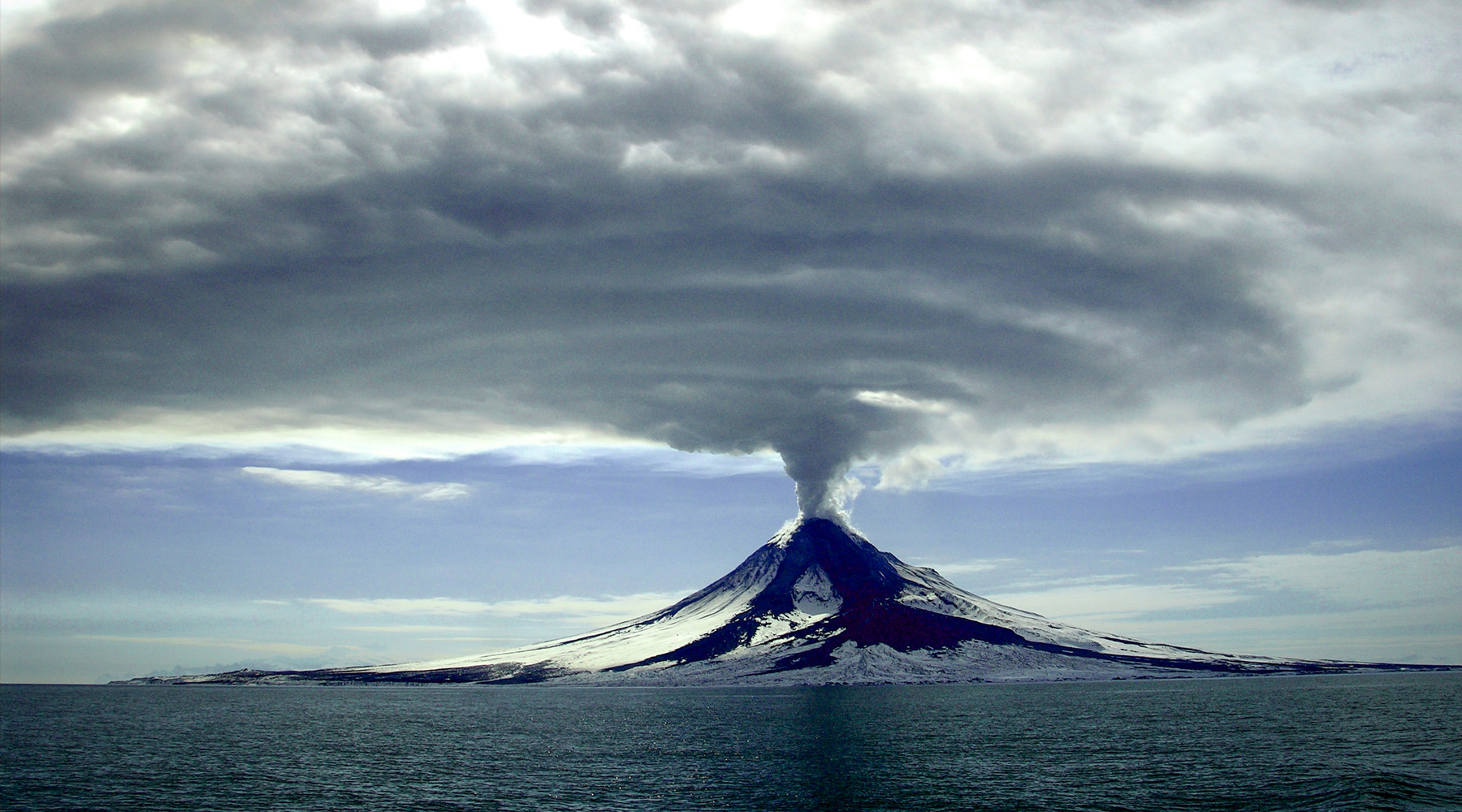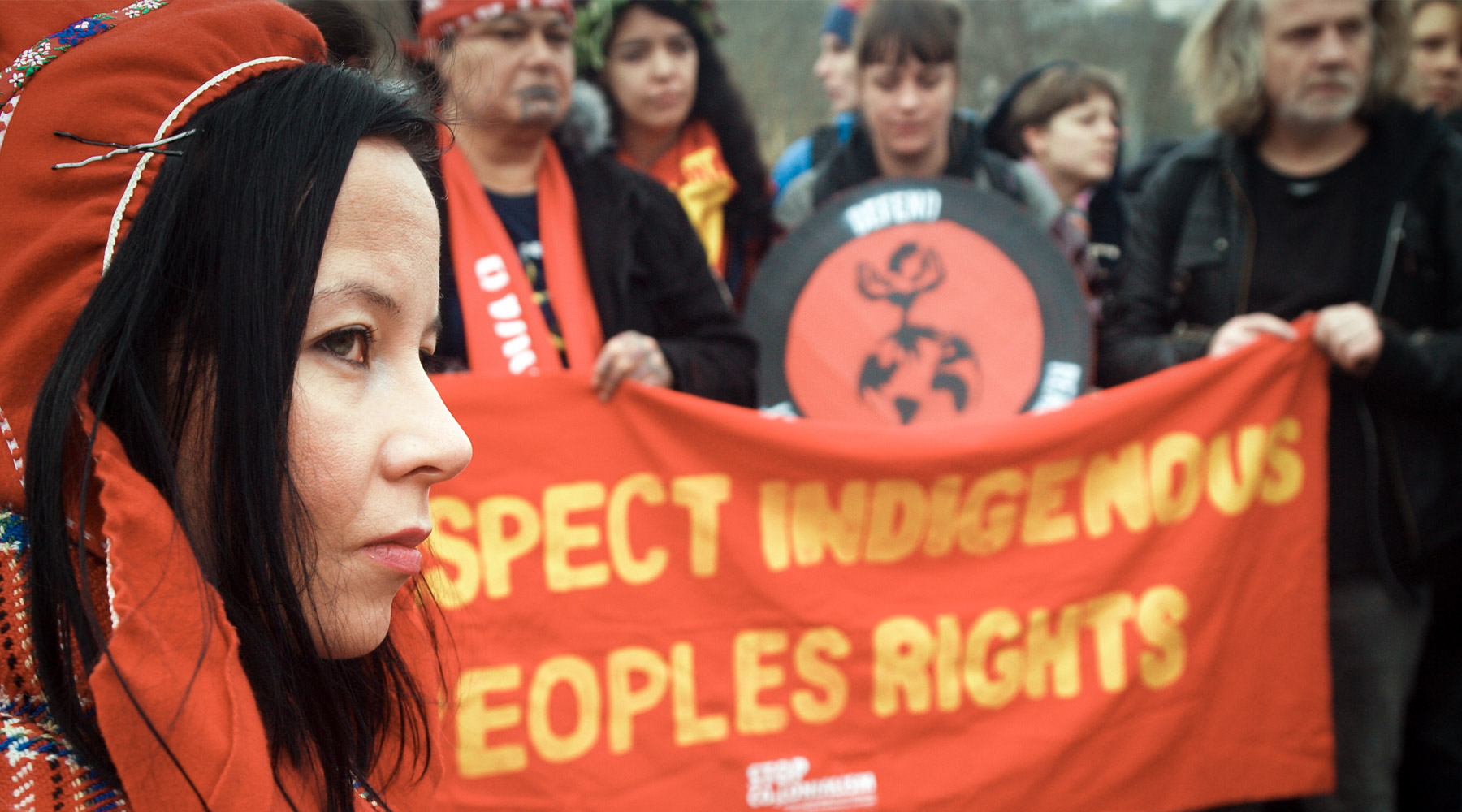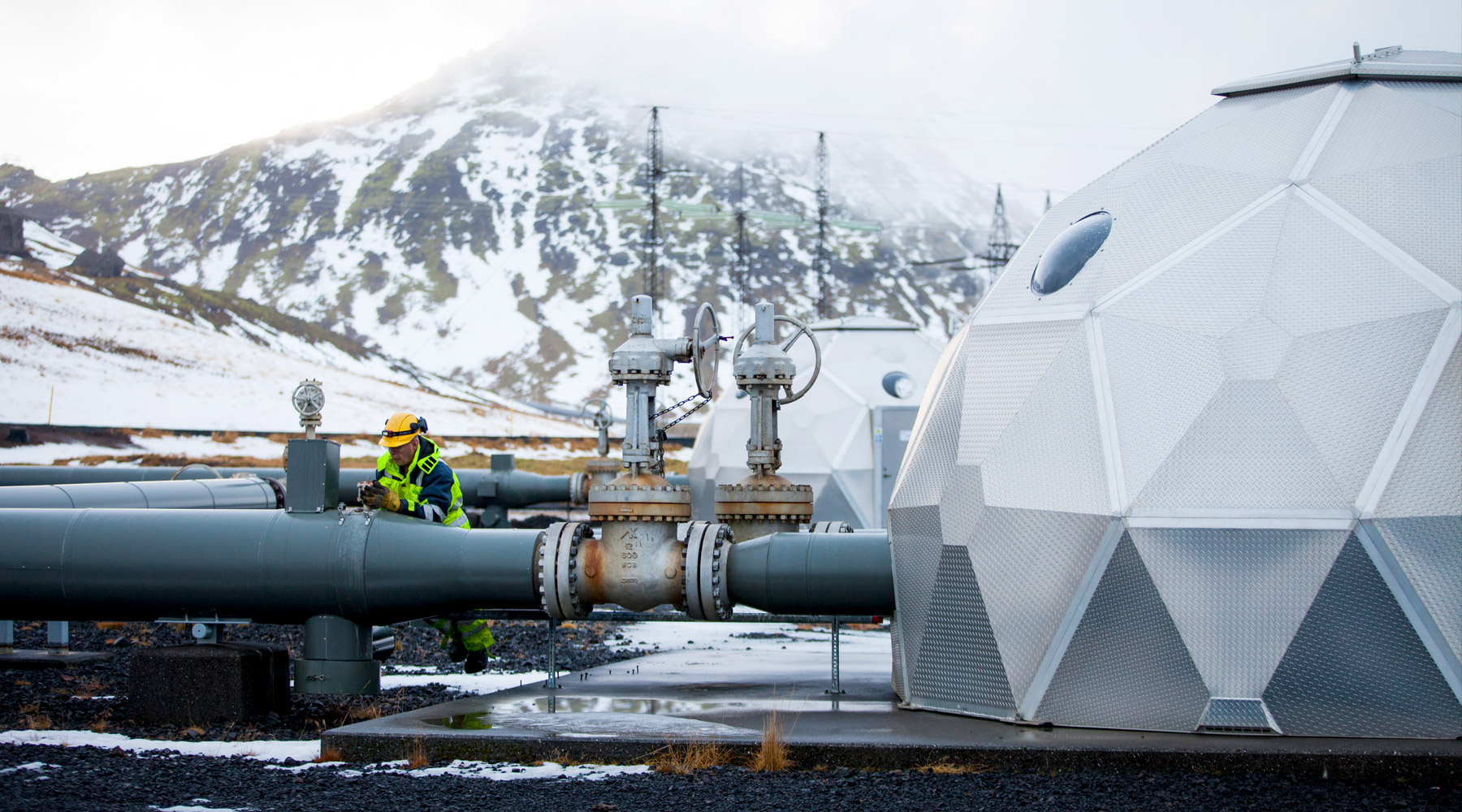

Inside Geoengineers’ Risky Plan To Block Out the Sun
Some scientists say it’s necessary to save the climate. An indigenous-led opposition says it will only save the fossil fuel economy.
November 15 | December 2018 Issue
We have only 12 years to cut greenhouse gas emissions by 45 percent, according to an October report from the Intergovernmental Panel on Climate Change (IPCC). The feat, it admits, would require “rapid, far-reaching” societal transformation. If we fail, coastal cities will be inundated, food will run short and the damage will cost $54 trillion by 2040, when babies born this year will be old enough to graduate from college.
The clear path to curbing these catastrophes involves rapidly phasing out carbonintensive fuels, which requires changes on a scale for which “There is no documented historic precedent,” the report’s authors note.
But more dramatic approaches have crept into policy discussions, like solar radiation management, known as SRM. First imagined by scientists during the Cold War, SRM promises a comparatively cheap, quick fix: the continuous dispersal of aerosols into the atmosphere to reflect and absorb sunlight, cooling the planet. In effect, SRM means dimming the sun.
For proof of concept, advocates look to volcanic eruptions, which spew out plumes of aerosols. The 1883 eruption of Krakatoa, for example, reportedly lowered global temperatures by 1 degree Celsius. The best modeling suggests SRM, too, would work like a charm.
Like a volcano, however, SRM is enormously risky. Side effects could include decreasing crop yields, melting the ozone layer or irreparably altering the water cycle, flooding some parts of the world while causing prolonged droughts in others—and those are just the few we are able to model.
If starting SRM is risky, so is stopping once we’ve started: Stanching the flow of aerosols would risk the Earth rapidly warming by several degrees within a decade, known as a “termination shock.” This sudden heating would do more damage than the current, more gradual warming, disrupting the climate while giving species and ecosystems little time to adapt.
But given the stakes, many SRM boosters say the benefits seem to outweigh the risk. After all, what choice do we have?
If it sounds like we’ve crossed into science fiction, we have: This scenario is more or less the opening narration of Geostorm, a critically panned 2017 film about climate-controlling satellites gone rogue. The better-received 2013 class-struggle flick Snowpiercer also starts with a similar premise: an attempted SRM-like scheme backfires into endless winter.
Yet SRM and other risky high-tech climate interventions inch closer to reality by the day. The IPCC report has reignited a long-running debate: How far are we willing to go, and what risks are we willing to take, to keep the Earth from further warming? Humans have altered the climate for centuries by pumping out greenhouse gases. What’s so different about interfering with the climate to save the world instead of cook it? Do we have any other options left?


Volcanic eruptions, like the 2006 Augustine Volcano eruption in Alaska, release plumes of aerosols into the atmosphere that can affect global temperatures, proof of concept for advocates of solar radiation management. (Photo by Smith Collection/GADO/Getty Images)
Stratospheric aerosol injection — the type of SRM described above—is one of a suite of technologies aimed at large-scale manipulation of the climate, known as geoengineering. There are two broad categories: solar geoengineering to block or reflect sunlight (like SRM), and “negative emissions technologies” to suck greenhouse gases out of the air. Negative emissions technologies have been factored into climate modeling for years and have a long-established (if controversial) role in IPCC mitigation strategies; solar geoengineering has been more fringe.
But in the past few years, the governments of the United Kingdom and United States have each sponsored research into solar geoengineering, outlets from The New Yorker to the New York Times have commissioned lengthy articles on it, and an editor at The Economist wrote a whole book on the subject, The Planet Remade. Just after the release of the new IPCC report, Council on Foreign Relations President Richard N. Haass opined that world governments should “accelerate R&D on geoengineering,” and Rep. Ro Khanna (D-Calif.) called to “incentivize oil companies to help.”
SRM has even found a research base in the Ivy League. Thanks to Harvard’s Solar Geoengineering Research Program, founded in 2017, the first steps toward implementation may soon float above the United States through the program’s Stratospheric Controlled Perturbation Experiment.
Known as Scopex, the experiment is not an SRM test, per se—to truly test the concept would require a global scale. But it is an attempt to go beyond computer modeling to understand the chemistry and microphysics of how particular aerosols interact with the stratosphere. A propeller-powered balloon will disseminate the aerosols; a small gondola, attached, will carry sensors. Researchers hope to launch in 2019.
Opposition to SRM has increased as well. As IPCC researchers met in South Korea to finalize their report, 110 civil society organizations across five continents, from First Nations peoples to think tanks to environmental NGOs, issued an anti-geoengineering manifesto: Hands Off Mother Earth, or HOME.
It reads, in part: “Geoengineering perpetuates the false belief that today’s unjust, ecologically and socially devastating industrial model of production and consumption cannot be changed and that we therefore need techno-fixes to tame its effects.” Signatories fear the development of SRM will be used as an excuse to continue the carbon status quo, calling it a “dangerous distraction” from real solutions and a “further entrenchment of fossil fuel economies.” Fossil fuel corporations have yet to throw their weight behind SRM specifically, but Shell’s chief climate change advisor, David Hone, praises the “sulphur solution” (referring to SRM) as the simplest in his book, Putting the Genie Back.
Harvard scientist David Keith, a contributor to the Scopex project, has emerged as something of a public face of SRM. He disagrees that geoengineering protects fossil fuel companies, envisioning it instead as a complement to decarbonization. “If solar geoengineering was much better understood, I don’t think it would make all the environmental forces give up and let Exxon win,” he says. “There’s not an alternative to cutting fossil fuels. We have to get them out of the energy system.”
Keith isn’t pushing for SRM deployment—just research— and says it’s important to understand all of the risks before moving forward. He worries about the Trump administration or other fossil fuel-friendly governments grasping onto SRM as a perceived quick fix. Still, he thinks we should be able to simultaneously research SRM and take action against fossil fuels.
The HOME manifesto, however, calls for a ban on open-air field experiments like Scopex. “[Scopex] makes no sense if you are not going to pursue deployment later,” says Silvia Ribeiro, one of the manifesto’s authors and the Latin America director of ETC Group, which addresses the social and environmental impacts of new technologies. “All powerful technologies have started with small experiments.”
Oxford physicist Raymond Pierrehumbert, a lead author on the IPCC’s third assessment report in 2001, sees Scopex as a crossing of the Rubicon. “Proceeding to field experimentation,” he writes, “crosses a thin red line beyond which lies the slippery slope down to ever-larger field trials and, ultimately, deployment.”
Skeptics also note that SRM only addresses some of the effects of global warming—those stemming directly from temperature. It does nothing to reduce the amount of carbon dioxide in the air, which means ocean acidification would continue apace, causing irreversible damage to coral reefs and other ocean life that will reverberate up the food chain. The continued accumulation of greenhouse gases would also heighten the impacts of potential termination shock.
Aerosol injections could increase exposure to UV radiation, as well, by wearing away at the ozone layer, most seriously at the North and South Poles, but also around the middle latitudes where most people live. Cooler temperatures do mean greater crop yields, which seems to be a mark in SRM’s favor. But a paper released this summer in Nature found that sunlight scattered by SRM would impede photosynthesis, negating any positive effects.
Study author Jonathan Proctor put it this way: “If we think of geoengineering as experimental surgery, our findings suggest that the side effects of treatment are as bad as the original disease.”
Even in the best case, the global effects of SRM will be extremely difficult to predict, says Janos Pasztor, director of the Carnegie Council for Geoengineering Governance Initiative. He is working on a regulatory framework around geoengineering research and deployment.
“The most important impact is hopefully positive, which is the reduction of global temperatures—otherwise you wouldn’t do it,” Pasztor says. But the most worrying effects may be what Pasztor calls the “unknown unknowns,” impacts we simply don’t know how to predict. “The global atmosphere is unbelievably complex,” he says. “We have advanced computer modeling with supercomputers, but we still don’t really know how to model it.” He believes better models and better data should be prerequisites for any deployment. “We only have one atmosphere, and we cannot mess it up.”
A small group of researchers in the Global North, dubbed the “Geoclique” by science writer Eli Kintisch, makes the case that it’s too soon to write off SRM, which accounts for a small percentage of climate research overall. While foundations and wealthy individuals have spent a few billion dollars on these efforts (most notably Bill Gates), clique members operate on modest budgets.
Another danger is that this so-called quick fix could be deployed unilaterally, side effects on everyone else be damned. It would cost just a few billion dollars a year to mount fleets of jets equipped with spray cannons, well within the means of a small country, a large corporation or a Bill Gates.
Could a group of low-lying countries, devastated by storms and rising seas, reach a tipping point and pull the trigger? Could deployment result from a geopolitical power play between the United States and China? Critics believe that the more SRM is legitimized through experiments and positive mainstream attention, the more likely it is that these speculative scenarios become real.
Volcanic eruptions, like the 2006 Augustine Volcano eruption in Alaska, release plumes of aerosols into the atmosphere that can affect global temperatures, proof of concept for advocates of solar radiation management. (Photo by Smith Collection/GADO/Getty Images)


Indigenous groups demand stronger action against the fossil fuel industry in Paris on Dec. 12, 2015, the day of the global climate deal’s adoption. (Photo by Fotoholica Press/Lightrocket via Getty Images)
Regardless, the scale of the climate crisis means more scientists and policymakers are now willing to consider SRM. But who gets to decide when to roll it out?
The United Nations Framework Convention on Climate Change (UNFCCC) is the body currently charged with negotiating climate policymaking at the international level. It took 20 years after parties to the UNFCCC began meeting for the world to first agree on a plan to mitigate climate change, the 2015 Paris Agreement.
It’s scandalous that the Paris Agreement took as long as it did and is as weak is it is, but the reasons aren’t hard to parse. International policymaking of any sort is notoriously difficult, especially for an issue that affects just about every sector of the global economy. Even small national delegations must delicately balance the demands of their governing parties with actors ranging from civil society to industry—some of which have been pumping out disinformation about climate change for decades.
An international agreement around solar geoengineering could mean starting from scratch, beginning with a push to convince the world’s governments that it’s necessary—assuming no rogue actor launches a project on its own, first. But the trouble isn’t, as writer Nathaniel Rich suggests in his recent blockbuster New York Times Magazine piece on the early days of international climate talks, that human beings are just bad at making these tough longterm decisions.
The democratic processes involved here are more about power than psychology—and certain actors exercise a lot of power in the UNFCCC process. Well before Donald Trump took off ice, the United States played an obstructionist role in UN climate talks, stymying speedier and more ambitious action to appease domestic fossil fuel interests. The Senate failed to ratify the Kyoto Protocol in 1997, for example, and the Obama administration argued against legally binding targets. The United States isn’t the only party impeding action, of course. But it’s very likely that the world would have arrived at a more effective climate agreement long before Paris were it not for the colossal influence of coal, oil and gas companies in U.S. politics.
In fact, as the nonprofit watchdog Corporate Accountability has detailed, major polluters are now actively trying to influence how the Paris Agreement gets implemented. The UNFCCC Climate Technology Network, for instance, which advises nations in the Global South on climate mitigation and adaptation, includes the World Coal Association.
The path laid out in the Paris Agreement is relatively straightforward: Stop using fossil fuels and start making massive investments in renewable energy. But considering the fight polluters are likely to put up, many scientists suspect that meeting the agreement’s goal of limiting global temperature rise to 1.5 degrees Celsius is, at this point, impossible, with scant hope of meeting even the back-up 2-degree goal. To avoid surpassing 1.5 degrees (without extensive use of negative emissions technologies), coal use would need to decline by 97 percent by 2050, oil by 87 percent and natural gas by 74 percent. While such a change is “possible within the laws of physics and chemistry,” according to the IPCC authors, the politics are tricky: It would mean “unprecedented changes in all aspects of society.”
Ellie Johnston leads global climate and energy efforts for the nonprofit Climate Interactive to help inform policymakers and the public. Using current economic parameters, she and her team tried to create a scenario to keep global temperature rise to 1.5 degrees without using large-scale carbon removal technologies.
They couldn’t do it. “In our model, we couldn’t recreate scenarios that follow those [steep] reduction rate curves and not adjust things like GDP,” Johnston says. Most models assume economic growth, which is generally linked to greater consumption, greater energy use and greater emissions. Changing these assumptions is “fraught territory that is politically very challenging in the academic literature,” she adds.
The IPCC itself, however, is starting to consider economic alternatives. Five alternate socioeconomic scenarios in the next IPCC assessment report will include one optimistic future in which “the emphasis on economic growth shifts toward a broader emphasis on human well-being,” according to the researchers’ summary. The HOME manifesto similarly calls for reduced energy and materials use alongside ecosystem restoration, a just transition for workers and respect for indigenous rights. It’s this potential for broader change that, for many, helps make decarbonization desirable: Done right, breaking society’s addiction to corporate profit creates space for a more equitable society.
Johnston’s team did find it was possible, without changing the parameters, to stay well below 2 degrees of warming, if not below 1.5. But, she says, “We had to throw every single lever we’ve got at it: a big carbon price, maxed-out energy efficiency, stopping deforestation.”
Indigenous groups demand stronger action against the fossil fuel industry in Paris on Dec. 12, 2015, the day of the global climate deal’s adoption. (Photo by Fotoholica Press/Lightrocket via Getty Images)


A pilot program at Reykjavik Energy’s Hellisheidi geothermal power plant removes carbon dioxide from the air, though so far it only offsets the equivalent of approximately one U.S. household. (Photo by Melanie Stetson Freeman / The Christian Science Monitor via Getty Images)
Geoengineering is broadly discussed by researchers as a tool to allow more time to achieve the goal of decarbonization, but SRM alone does nothing to reduce carbon dioxide. Meanwhile, negative emissions technologies—actually removing carbon from the atmosphere—are seen by many as a core part of the solution. The IPCC report authors expect them to play a central role in restricting warming to 1.5 degrees.
But the problem, as Johnston says, is that “we’re betting on this technology that doesn’t even exist.”
“It’s still to be proven that there is anything called negative emissions,” Ribeiro contends, at least at any scale envisioned by the IPCC report. Some negative emissions technologies do exist, such as the low-tech tactic of planting new forests. Others, like carbon capture and storage (CCS) technology to suck up emissions from fossil-fuel power plants, are further off and still incredibly expensive. According to the Global CCS Institute, 18 large-scale operational facilities utilize CCS worldwide, a small fraction of what the IPCC calls for. At 14 of these, the captured gas is simply used to help fossil fuel extraction efforts elsewhere.
Other possible technologies include what is known as “bio-energy with carbon capture and storage” (BECCS). BECCS involves planting prodigious amounts of fast-growing trees, burning them for energy, then capturing those emissions with CCS. Because plants take in carbon as they grow, the process would theoretically be carbon negative. At scale, however, it could involve requisitioning a land mass twice the size of India, note climate scientists Kevin Anderson and Glen Peters. Setting aside this much land, some fear, could compete with food production and cause massive human displacement.
Another infant tech is “direct air capture” (DAC), sucking carbon dioxide directly out of the air rather than from an industrial process. One company, Global Thermostat, has partnered with a soft drink manufacturer to use its captured gas in the production of bottles and carbonated beverages. Another firm, Carbon Engineering, founded by Harvard’s David Keith and backed by a host of Silicon Valley types, hopes to create and market synthetic fuels with its carbon harvest, combining it with hydrogen and water. Early DAC prototypes have been promising, but are still a long way from the kind of scale needed by IPCC models.
The HOME manifesto opposes all of these technologies, wary that they will be used as an excuse to extend the life of coal, oil and gas power, and that their large-scale implementation would require unsustainable levels of energy, land, water and other resources.
The signatories charge that the impacts of this resource use—as well as the other side effects of SRM—would disproportionately harm small farmers and indigenous communities, who would be most vulnerable to any crop reductions caused by SRM or potential land grabs for bioenergy production. What’s more, they believe, early experiments are being pushed through without popular consent.
Similar charges could also be lobbed at global warming itself: Rich countries are the primary cause, and the global poor will bear the brunt of the effects. Indeed, some of these communities may now find themselves confronting two very different kinds of man-made climate interventions at once.
Utqiaġvik, Alaska, has been described as a ground zero for climate change. On Inupiaq land along the Arctic Sea, temperatures are rising faster than anywhere else in the world. Last year, the National Oceanic and Atmospheric Administration’s temperature monitor algorithms incorrectly rejected read-outs for the area as unrealistic; average October temperatures, for instance, have risen 8 degrees Fahrenheit since 2000. As a result, permafrost is melting, ice is thinning and species of insect no one alive can remember seeing there, including tree-killing spruce bark beetles, are beginning to invade.
“It’s made life harder,” says Adrienne Aakaluk Titus, an Inupiaq organizer with the nonprofit Native Movement who works with Utqiaġvik residents. “We have to travel farther to go hunting, and the farther out you have to travel, the more dangerous it gets.”
For the last decade or so, Utqiaġvik has also been ground zero for a type of “soft” geoengineering known as ice thickening: spreading out white silica sand to reflect the sun and prevent ice from melting. The project, known as Ice911, is the brainchild of Bay Area-based engineer Leslie Field, who has 12 years of field trials under her belt.
Geoengineering Monitor, a collaboration between ETC Group and other environmental organizations, fears the project could disrupt weather patterns and animal migrations, though Ice911 maintains that, if any negative effects arise, the process is easily reversible.
Field emphasized how important she saw the permitting process and collaboration with the Utqiaġvik Inupiaq Corporation, one of several for-profit Alaska Native corporations set up by the federal government to settle land and property claims brought by indigenous communities. There are tensions, however, between Native corporation executives, seven of whom each make at least $1 million a year, and the people who live with the decisions those executives make.
“Permission is easy,” Titus says. “You can go into an office and you can sign for a permit. That’s the law. Consent is another matter.” Titus says that few of the Utqiaġvik residents she had spoken with had heard of Ice911, and were surprised to learn about its existence.
HOME manifesto signatory Tupac Enrique Acosta is a longtime organizer and founder of the indigenous environmental organization Tonatierra. He sees geoengineering as “built upon a predatory relationship with the natural world,” and the push to test and implement geoengineering in indigenous-populated areas as an extension of colonization: “They put wings on the Niña, the Pinta and the Santa María and they’re flying them up there in the sky.”
For both Acosta and Titus, however, concerns about geoengineering tests extend beyond process. “I think [ice thickening] is a false climate solution,” Titus says. “There are so many other things we could be doing. We don’t need another Band-Aid.”
In the wake of the new IPCC report, the challenges posed by geoengineering aren’t really so different than those surrounding the climate crisis writ large. In both cases, the greatest uncertainties have less to do with science and technology than with democracy. Who decides what technologies are necessary, who controls them and who profits? What sacrifices will be made by whom, and who gets to make that call? 
is a Brooklyn-based journalist covering climate and U.S. politics, and a contributing writer to In These Times and The Intercept.
Correction: The print version of this article stated erroneously that opposition to the Kyoto Protocol and binding climate commitments stemmed from the Clinton administration. The article has been updated to reflect.
Support Independent Journalism
In These Times has been selected to participate in NewsMatch 2018—the largest grassroots fundraising campaign for nonprofit news organizations.
For a limited time, when you make a tax-deductible donation to support our reporting, it will be matched dollar-for-dollar by the NewsMatch fund, doubling your impact.
A pilot program at Reykjavik Energy’s Hellisheidi geothermal power plant removes carbon dioxide from the air, though so far it only offsets the equivalent of approximately one U.S. household. (Photo by Melanie Stetson Freeman / The Christian Science Monitor via Getty Images)
